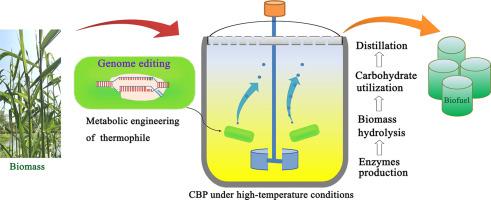Biofuel production from lignocellulose via thermophile-based consolidated bioprocessing
引用次数: 0
Abstract
The depletion of fossil fuels and their impact on the environment have led to efforts to develop alternative sustainable fuels. While biofuel derived from lignocellulose is considered a sustainable, renewable, and green energy source, enhancing biofuel production and achieving a cost-effective bioconversion of lignocellulose at existing bio-refineries remains a challenge. Consolidated bioprocessing (CBP) using thermophiles can simplify this operation by integrating multiple processes, such as hydrolytic enzyme production, lignocellulose degradation, biofuel fermentation, and product distillation. This paper reviews recent developments in the conversion of lignocellulose to biofuel using thermophile-based CBP. First, advances in thermostable enzyme and thermophilic lignocellulolytic microorganism discovery and development for lignocellulosic biorefinery use are outlined. Then, several thermophilic CBP candidates and thermophilic microbes engineered to drive CBP of lignocellulose are reviewed. CRISPR/Cas-based genome editing tools developed for thermophiles are also highlighted. The potential applications of the Design-Build-Test-Learn (DBTL) synthetic biology strategy for designing and constructing thermophilic CBP hosts are also discussed in detail. Overall, this review illustrates how to develop highly sophisticated thermophilic CBP hosts for use in lignocellulosic biorefinery applications.

通过基于嗜热菌的综合生物加工技术利用木质纤维素生产生物燃料
化石燃料的枯竭及其对环境的影响促使人们努力开发可持续的替代燃料。虽然从木质纤维素中提取的生物燃料被认为是一种可持续、可再生的绿色能源,但在现有的生物精炼厂中提高生物燃料产量和实现木质纤维素的生物转化的成本效益仍然是一项挑战。使用嗜热菌的综合生物处理(CBP)可将水解酶生产、木质纤维素降解、生物燃料发酵和产品蒸馏等多个过程整合在一起,从而简化操作。本文回顾了利用嗜热菌 CBP 将木质纤维素转化为生物燃料的最新进展。首先,概述了用于木质纤维素生物炼制的恒温酶和嗜热木质纤维素分解微生物的发现和开发进展。然后,综述了几种嗜热 CBP 候选者和经改造可驱动木质纤维素 CBP 的嗜热微生物。此外,还重点介绍了为嗜热微生物开发的基于 CRISPR/Cas 的基因组编辑工具。还详细讨论了设计-构建-测试-学习(DBTL)合成生物学策略在设计和构建嗜热 CBP 宿主方面的潜在应用。总之,本综述说明了如何开发高度复杂的嗜热 CBP 宿主,用于木质纤维素生物精炼应用。
本文章由计算机程序翻译,如有差异,请以英文原文为准。
求助全文
约1分钟内获得全文
求助全文

 求助内容:
求助内容: 应助结果提醒方式:
应助结果提醒方式:


